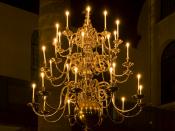At a time where the American people are living in a state of limbo between fear and power, a piece of home is much welcomed. Those who lost loved ones in 9/11 or in the continuous war look for memories in the (smallest) things. Objects in a family room tend to keep memories, and the mere sight of them releases these memories. This idea is shown through a very elaborate chandelier photographed by Edward Bernstein in three separate prints, Constellation I, II, and III.
Edward Bernstein uses light and shadow to portray the good and bad of the past. Just as a memory can be fuzzy and hard to grasp, the print is blurry and almost illusive. The pale lights suggest distance, and even someone (the viewer) being swallowed by an empty, lifeless room. Chandeliers of this size don't usually appear in homes, rather they are hanging from intricately designed ceilings of ballrooms and hotels.
They give a sense of high class with a touch of elegance. Just looking at this print reminds most of proms, large occasions, awards, and even dark funerals. The light, which almost looks flickering, gives a sense of fading as if the memory is fading also. The chandelier has three tiers which are all connected by glass strands of hope. The shadow effectively gives the viewer a sense of past and presence, with the light representing the present, near future. The movie, Blow, showed the cocaine dealer's house in which he had a large chandelier. He valued his dining room in which the chandelier was placed, and throughout the movie you could see the good and bad, even what the future held. To him, this was the centerpiece of his family life in his household.
The long curved, lifeless limbs of the chandelier and the...


